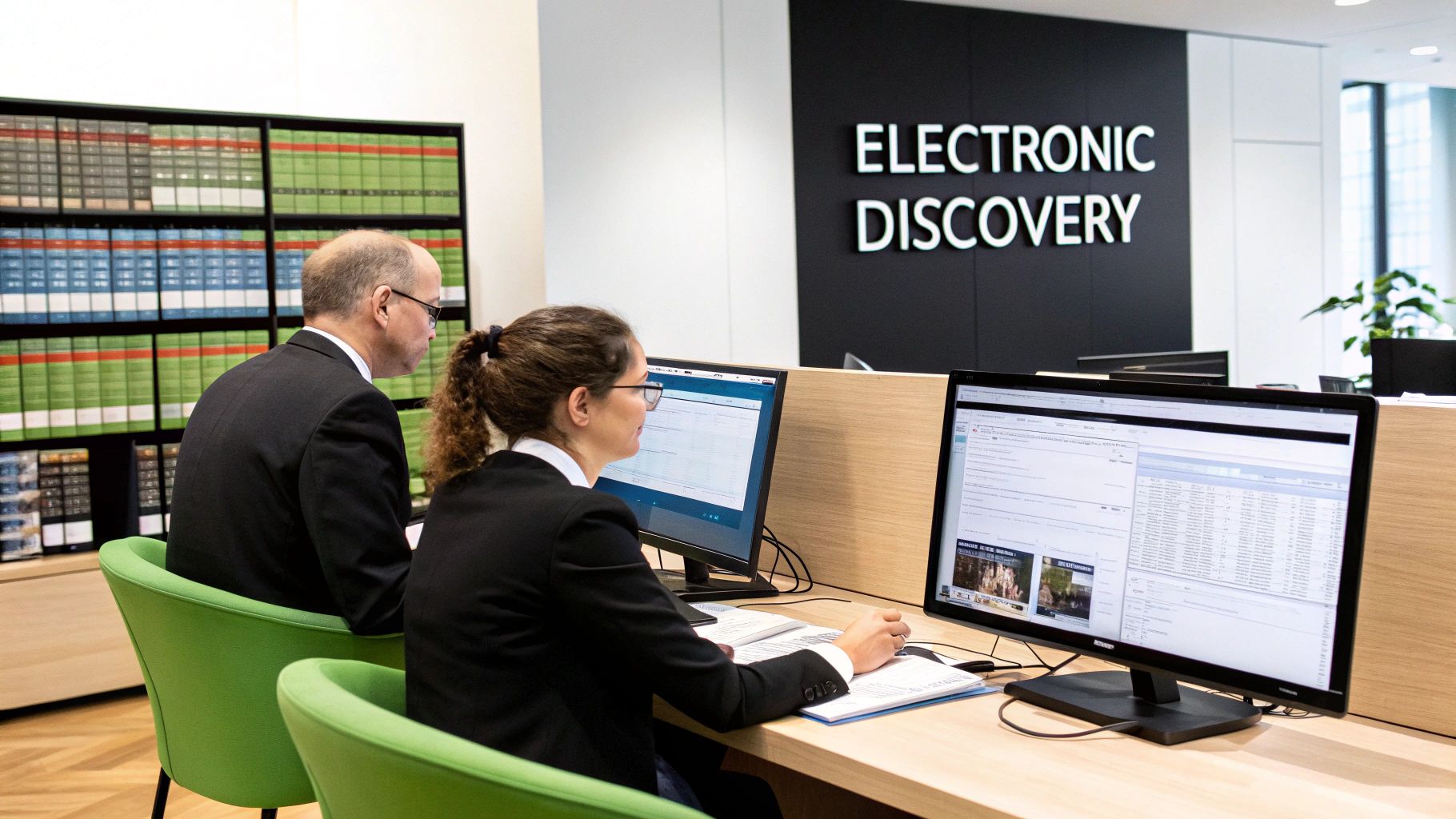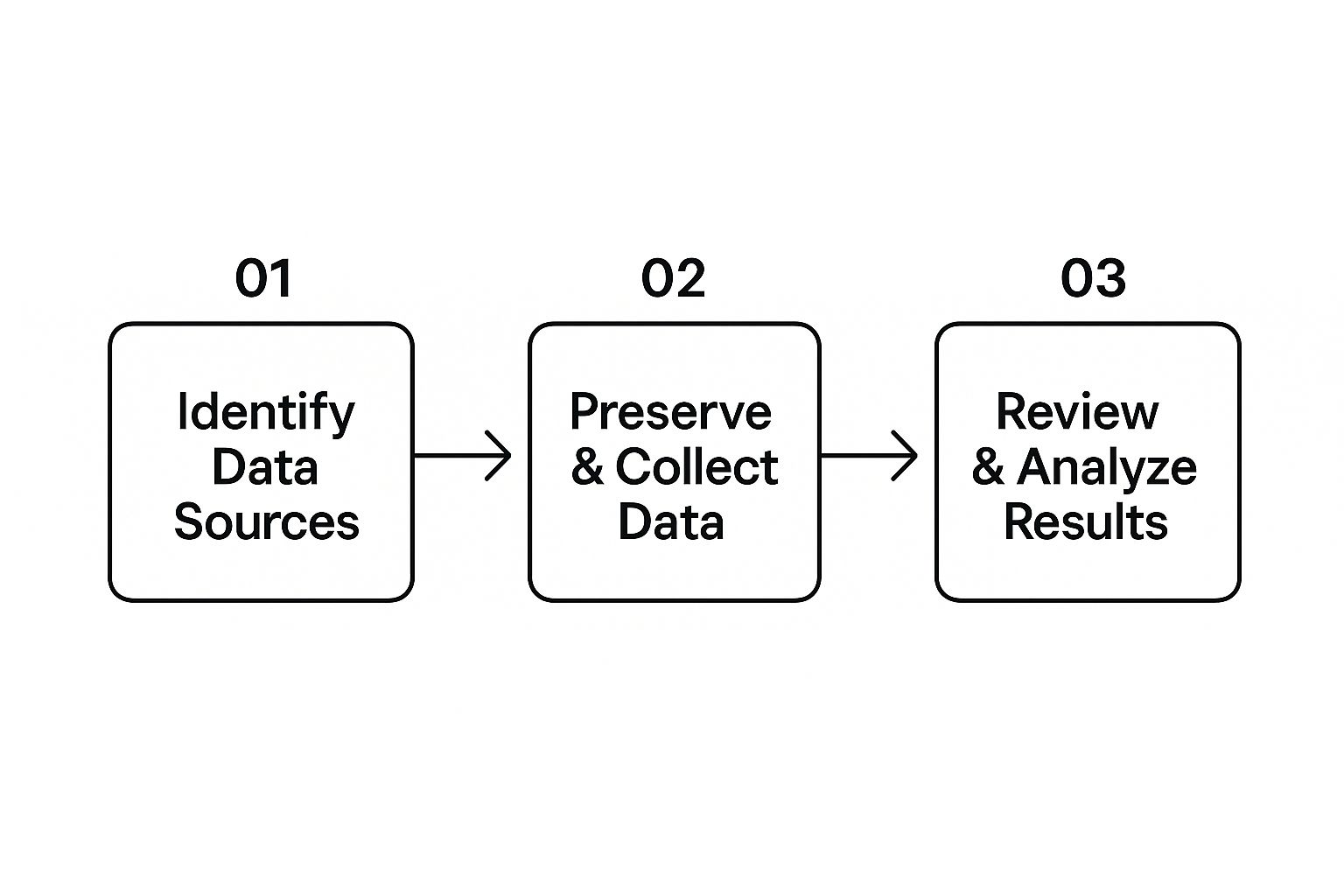By Pablo Tascon
An electronic discovery service is a specialized offering that helps legal teams cut through the noise. It’s a mix of advanced technology and expert human guidance, designed to manage the entire process of finding, collecting, preserving, and reviewing electronically stored information (ESI) for a lawsuit or investigation. Think emails, cloud drives, and even Slack messages.
Navigating the Digital Maze of Modern Evidence

Picture a company getting slapped with a lawsuit. Twenty years ago, the legal team would have marched into a records room stacked high with filing cabinets. Today, that "room" is a sprawling, chaotic digital maze.
The key evidence isn't tucked away in a neat folder. It's scattered across thousands of emails, buried in countless Microsoft Teams channels, hiding in SharePoint project files, and sitting on dozens of employee laptops.
The Challenge of the Digital Deluge
This is the new reality. The sheer volume and variety of ESI have exploded, making the job of finding relevant information feel like searching for a needle in a digital haystack. A single employee can generate thousands of data points a day, from quick instant messages to tiny edits on a shared document.
The real problem isn’t just the amount of data; it’s the complexity. Digital evidence is alive. It contains metadata—things like when a file was created or who last opened it—that can be just as critical as the content itself. One wrong move can lead to spoliation, where evidence is accidentally altered or deleted, bringing severe penalties from the court.
This digital flood creates a few massive headaches:
- Data Preservation: How do you stop potentially crucial data from being deleted as part of routine business operations?
- Collection Complexity: How can you defensibly gather information from all these different sources without bringing the company to a standstill?
- Review Burden: Sifting through terabytes of information by hand is not just impractical—it's incredibly expensive and a recipe for human error.
An effective electronic discovery service tackles these problems head-on. It's not about just finding one specific email. It’s about implementing a structured, defensible process to manage the entire lifecycle of digital evidence.
Keeping a clean, unbroken record of how data is handled is everything. Understanding the digital chain of custody is non-negotiable for proving that your evidence is sound. An expert service makes sure that chain remains intact from the moment data is collected to the day it’s presented in court, giving your legal team the solid foundation it needs to build its case. This is where professional help becomes essential.
Mapping The Journey Of Electronic Evidence
To make sense of electronic discovery, you need a reliable map. The industry standard for this is the Electronic Discovery Reference Model (EDRM), a framework that lays out the entire lifecycle of electronically stored information (ESI) in a legal matter.
Think of it less like a rigid legal procedure and more like a careful archaeological dig. You wouldn't just show up to a historical site and start digging randomly, right? The same logic applies here. An electronic discovery service follows a structured, defensible workflow to make sure every piece of digital evidence is handled correctly, preserving its integrity from start to finish. This methodical approach is what prevents critical information from being missed, mishandled, or compromised.
The Phases of the EDRM Workflow
The EDRM isn't a straight line—it’s common to circle back to earlier stages as a case evolves and you learn more. But it does provide a clear, logical sequence that guides the journey of digital evidence. Each phase has a specific job, building on the last to create a complete and defensible picture for legal teams to review.
This flow chart gives you a great visual of the core sequence: figuring out where data lives, locking it down, gathering it, and finally, making sense of what you've found.

The model hammers home a core principle of eDiscovery: you have to know what you have before you can effectively preserve, collect, and analyze it.
From Identification to Presentation
Let’s walk through the key stages, sticking with our archaeological dig analogy to make things clearer. Getting each of these phases right is non-negotiable for a sound, defensible process.
The EDRM provides a structured map for handling ESI. The table below breaks down each stage, its primary goal, and a typical activity you'd see.
| EDRM Stage | Primary Goal | Example Activity |
|---|---|---|
| Information Governance | Proactively manage data before litigation arises. | Creating a data map or retention policy. |
| Identification | Locate potentially relevant data sources and custodians. | Interviewing key employees to find where they store files. |
| Preservation | Protect data from being altered or deleted. | Issuing a legal hold notice to custodians. |
| Collection | Gather ESI for processing and review. | Making a forensic copy of a hard drive or exporting a mailbox. |
| Processing | Prepare collected data for review by filtering and indexing. | Removing system files and extracting metadata like dates and authors. |
| Review | Examine documents for relevance and privilege. | Attorneys tagging documents as "Relevant" or "Privileged" in a review platform. |
| Analysis | Uncover patterns, topics, and key insights from the data. | Using keyword searches or concept clustering to find important themes. |
| Production | Deliver relevant, non-privileged data to opposing counsel. | Exporting relevant documents in a specific format like PDF or TIFF. |
| Presentation | Use the evidence in depositions, hearings, or trial. | Displaying a key email or document as an exhibit in court. |
Each stage builds on the one before it, forming a chain of custody that ensures the evidence remains defensible from its source all the way to the courtroom.
A Deeper Dive Into the Stages
-
Information Governance: This is all the prep work—understanding your data landscape before a legal matter ever lands on your desk. It’s like knowing the historical significance of a site before you even think about breaking ground.
-
Identification: Once a legal hold is in place, the hunt begins to identify potentially relevant ESI. This is the survey phase, where archaeologists use ground-penetrating radar to pinpoint where artifacts might be buried.
-
Preservation: Next, you have to lock down that evidence to stop anyone from changing or deleting it. This is the equivalent of roping off the dig site, making sure no one contaminates the area or walks off with important finds.
-
Collection: Now it’s time to carefully gather the ESI. An archaeologist meticulously excavates, documenting an artifact's exact location and condition. A sloppy collection can damage digital evidence just as easily as a shovel can crack ancient pottery.
The real make-or-break point for any electronic discovery service is the methodical execution of these early stages. A mistake during preservation or collection can have devastating consequences, potentially getting crucial evidence thrown out of court.
-
Processing: This stage is about converting all that raw data into a format that’s ready for legal review. Think of this as the lab work, where artifacts are cleaned, cataloged, and prepped for close examination. During processing, metadata gets extracted, and all the irrelevant system files are filtered out.
-
Review: This is where the legal team digs in, examining the processed data to decide what's relevant to the case and what's not. It's the moment archaeologists finally get to study each artifact, figuring out what it means and how it relates to everything else they’ve found.
-
Analysis: Here, you’re looking deeper at the ESI for context, trying to identify key patterns, people, and topics. This is the storytelling phase, where individual artifacts are woven into a coherent narrative about what happened.
-
Production: All the relevant ESI is then delivered to the other parties in an agreed-upon format. This is like preparing artifacts for a museum exhibit, complete with all the proper documentation. To learn more, check out our guide on creating effective ESI protocols in litigation.
-
Presentation: Finally, the evidence is presented in depositions, hearings, or at trial. This is the grand reveal—where the story uncovered during the dig is shared with the world.
The Toolkit of a Modern eDiscovery Service

Now that we've mapped out the workflow, let’s peek inside the high-tech workshop that powers a modern electronic discovery service. This isn’t just about having the right software; it’s a powerful blend of sophisticated technology and deep human expertise. Each component is there for one reason: to find the smoking gun faster, more accurately, and at a fraction of the cost of doing it the old-fashioned way.
Think of it as moving from a basic keyword search to an intelligent investigation. Instead of just flagging specific words, these tools understand context, concepts, and relationships hidden in the data. This shift is crucial, especially when the amount of electronic information just keeps exploding.
And the demand for these advanced tools is skyrocketing. The U.S. electronic discovery market hit roughly USD 6.56 billion in 2024 and is only expected to climb. This growth is a direct result of the explosion in complex digital data, which is pushing legal teams to find smarter ways to handle discovery. You can dig deeper into the eDiscovery market growth on Grandview Research.
Advanced Analytics and Concept Searching
At the heart of any modern toolkit, you’ll find advanced analytics. This technology is light-years beyond old-school keyword searching, which famously returns thousands of useless documents for every relevant one. Analytics engines use a form of AI to perform concept searching.
Here’s a practical example: searching for the keyword "contract" might completely miss emails discussing a "master services agreement" or an "MSA." Concept searching is smart enough to know these are all related ideas. It retrieves all of them, regardless of the exact phrasing, uncovering evidence that would otherwise stay buried.
Technology-Assisted Review (TAR)
Another cornerstone is Technology-Assisted Review (TAR), often called predictive coding. TAR uses machine learning to tackle the most expensive and time-consuming part of eDiscovery: having humans review every single document.
Here’s a simplified breakdown of how it works:
- Initial Seeding: A senior attorney or someone who knows the case inside and out reviews a small, random batch of documents. They simply code them as "relevant" or "not relevant."
- Machine Learning: The TAR system analyzes those decisions, learning what makes a document relevant in this specific case.
- Iterative Training: From there, the system starts prioritizing the entire document collection, feeding reviewers the files it predicts are most likely to be relevant. As reviewers keep coding, the system gets smarter and more accurate with each pass.
By learning directly from human experts, TAR can accurately code millions of documents with minimal human oversight. It cuts review time dramatically while creating a consistent, defensible process. It’s like having a team of paralegals working at machine speed.
This modern toolkit—a combination of intelligent analytics, TAR, secure hosting, and managed review—turns a burdensome legal requirement into a manageable, strategic process. It frees up legal teams to focus on what really matters: building their case, not drowning in data.
How AI Is Reshaping Electronic Discovery
The engine powering modern electronic discovery services is artificial intelligence. What once felt like a sci-fi concept is now the industry standard for wrestling with the mountains of data that come with litigation and investigations. AI, and specifically machine learning, fundamentally changes the game from a manual, human-powered slog to a smart, automated process.
Think about how a streaming service learns what you like to watch. After a few sci-fi movies, it doesn't just suggest more sci-fi. It picks up on the specific patterns you enjoy—maybe complex plots or a certain director—and recommends films that match. AI in eDiscovery operates on the exact same principle, but instead of analyzing movies, it’s analyzing legal documents for relevance.
This shift is fueling massive growth and innovation in legal tech. The global eDiscovery market was valued at USD 15.09 billion in 2023 and is on track to hit USD 22.65 billion by 2028. AI-driven software is a huge part of that, growing at an impressive 11.4% CAGR. That boom isn't just hype; it's a direct response to the urgent need for smarter, faster ways to make sense of data. For more stats, check out the global eDiscovery market report on electroiq.com.
Predictive Coding in Action
You can see this intelligence at work most clearly in predictive coding, a type of Technology-Assisted Review (TAR). It all starts with a human expert—a senior lawyer who knows the case inside and out. They review a small, representative sample of documents, tagging each one as "relevant" or "not relevant."
The AI system watches these decisions, learns the characteristics that make a document relevant, and then applies that logic to the entire dataset. It then starts ranking the rest of the documents, pushing what it thinks is most important to the front of the line for human reviewers. With every new decision a reviewer makes, the AI gets smarter and refines its accuracy. This constant feedback loop slashes review time and cuts down on the risk of human error or inconsistency.
Predictive coding lets a small team of experts do the work that once took an army of reviewers. It turns document review from a brute-force effort into a focused, intelligence-driven exercise.
The Power of Cloud-Based Platforms
This technological jump is delivered through cloud-based eDiscovery platforms. These systems give legal teams a centralized, secure hub where they can collaborate from anywhere in the world. They can scale up or down to handle any case, from a small internal investigation to multi-terabyte, cross-border litigation.
Cloud platforms also solve the headache of version control and data silos by ensuring everyone is working from the same, up-to-date information. AI tools are baked right in, creating a powerful, all-in-one environment for the entire discovery process. It’s a complete game-changer compared to the old, clunky manual methods. To see how these technologies work together, you can learn more about how generative AI transforms eDiscovery in our deep-dive article.
Choosing the Right eDiscovery Partner

Picking an electronic discovery service isn't like hiring a typical vendor. It’s more like choosing a co-pilot for high-stakes litigation. Get it right, and your partner becomes an extension of your legal team, providing the technical muscle and strategic guidance you need to cut through complex data challenges. Get it wrong, and you’re looking at missed deadlines, blown budgets, and even court sanctions.
The right choice requires looking past a slick sales pitch and digging into what a provider can actually do. You need a partner who gets the technology, yes, but who also understands the legal realities you face every day. Their performance has a direct line to your ability to build a defensible and compelling case.
Key Evaluation Criteria
To properly vet a potential eDiscovery partner, you need a structured approach. I recommend focusing on three core areas: technical competence, security posture, and business transparency. Asking sharp, targeted questions here will quickly separate the real experts from the rest.
Here are the essential questions you should be asking:
-
Experience with Modern Data Sources: "Can you show us case studies where you've handled data from platforms like Slack, Microsoft Teams, or mobile devices?" A provider’s ability to defensibly collect and process data from these collaboration tools is no longer a nice-to-have—it's a baseline requirement.
-
Security and Compliance Certifications: "What security certifications do you hold, like ISO 27001 or SOC 2 Type II?" These independent audits are proof that a provider takes data protection seriously and has the controls in place to guard your sensitive client information.
-
Pricing Model Transparency: "Can you give us a detailed breakdown of your pricing structure? What’s included per gigabyte, and what’s billed separately?" Vague pricing models are notorious for hiding expensive surprises. A trustworthy partner will offer a clear, predictable model without hidden fees for things like project management or data production.
The goal is to find a partner who operates with complete transparency. Their willingness to provide clear answers on security, experience, and pricing is often a direct reflection of the quality of service you can expect when a critical deadline is looming.
Looking Beyond the Checklist
Beyond these foundational questions, think about the human element. Is their team made up of seasoned project managers and forensic experts? Do they offer strategic advice, or do they just process data as instructed?
A truly great electronic discovery service acts as a strategic advisor. They help you craft a proportional discovery plan that will hold up under judicial scrutiny. They become a partner in your success, not just another vendor fulfilling a work order.
Nailing Your Next eDiscovery Project: Critical Best Practices
Getting eDiscovery right isn't just about hiring a good vendor; it’s about having a smart game plan from day one. A proactive strategy is your best defense against the usual suspects: spiraling costs, blown deadlines, and mistakes that could have been easily avoided. Think of these best practices as a roadmap to turn a chaotic process into a predictable one.
It all starts with Early Case Assessment (ECA). Don’t just sit around waiting for discovery requests to land in your inbox before you start looking at your own data. Getting a handle on your ESI landscape right at the outset lets you quickly size up the scope of the project, pinpoint who the key players (custodians) are, and put together a budget that isn't just a wild guess. This early work stops nasty surprises down the road and puts you in a much stronger position for negotiations.
Get Your Protocols and Communication Ironed Out
Next up, lock down clear and defensible protocols. This is huge. You need to agree with the opposing side on things like search terms, date ranges, and what format the final production will be in before you even think about collecting data. Getting these details hammered out in a formal ESI protocol is the single best way to avoid expensive, time-wasting fights and motions to compel later on.
Internally, you need seamless communication between your legal team, the IT department, and your eDiscovery provider. Each group has a critical piece of the puzzle, and they need to be talking to each other constantly.
- Your Legal Team: They drive the case strategy and decide what's relevant and what's not.
- Your IT Department: They know the data infrastructure inside and out—where things are, how they're stored, and any technical hurdles you might face.
- Your eDiscovery Provider: They’re the specialists who bridge the gap, bringing the right tools and workflow expertise to the table.
Regular check-ins and a shared project plan keep everyone on the same page and moving in the same direction. It’s the simplest way to prevent missteps that could put your entire case at risk.
Finally, and this is non-negotiable, you must maintain a defensible audit trail. Every single action—from the moment a legal hold is issued to the final production of data—has to be meticulously documented. This chain of custody is your proof that the process was reasonable, consistent, and handled in good faith.
When you put these practices into play, you shift eDiscovery from a reactive, messy scramble into a structured, predictable, and—most importantly—defensible part of your legal strategy.
Frequently Asked Questions About eDiscovery Services
When you're looking at bringing on an eDiscovery partner, a lot of practical questions come up. Let's tackle some of the most common ones legal teams ask when they're weighing their options.
How Is The Cost of an Electronic Discovery Service Calculated?
Most providers bill based on the amount of data you're working with, usually measured in gigabytes (GB). A typical invoice might include separate line items for collecting data, processing it, hosting it each month, and licenses for each user on the review platform. It can get complicated fast.
Some firms are moving toward more straightforward, all-in pricing to get rid of those surprise bills. Always, and I mean always, ask for a detailed cost breakdown. You need to know exactly what’s included and what could show up as an extra charge later, like project management time or fees to produce the final data set.
Be wary of pricing models that look cheap at first glance but are loaded with hidden variable costs. A partner who offers clear, predictable pricing isn't just being transparent—they're showing you they're focused on delivering real value, not on nickel-and-diming you for every gigabyte.
What Is The Difference Between eDiscovery Software and a Managed Service?
The real difference comes down to who does the work.
eDiscovery software is a DIY approach. You license the platform, and your team is on the hook for managing the entire process from start to finish. This gives you maximum control, but it also demands serious in-house expertise to run effectively.
A managed electronic discovery service, on the other hand, gives you both the technology and the team. The provider’s own project managers, analysts, and forensic experts handle all the technical heavy lifting—from collection all the way to production. They essentially become an extension of your legal team, which is perfect for firms that don't have a dedicated eDiscovery specialist on staff.
What Kinds of Data Can an eDiscovery Service Handle?
Modern eDiscovery services go way beyond simple emails and Word documents. The game has changed, and a good provider has the expertise to handle the complex, messy data sources that are at the heart of most cases today.
This includes things like:
- Collaboration Platforms: Pulling content from tools like Slack and Microsoft Teams, making sure to preserve the conversational context so it all makes sense.
- Mobile Devices: Extracting text messages, call logs, and app data from smartphones and tablets.
- Cloud Storage: Collecting files from cloud services like OneDrive, Google Drive, and Dropbox.
- Structured Data: Digging into information stored in databases and other specialized business systems.
How Do You Ensure Data Security During The Process?
Any provider worth their salt will have a multi-layered security strategy. It all starts with the physical infrastructure, like using highly secure, Tier IV data centers, and employing robust encryption for all data, whether it's being transferred or just sitting on a server.
They also prove their security chops by adhering to globally recognized standards and certifications, particularly ISO 27001 and SOC 2 Type II. These aren't just fancy badges; they mean the provider has passed rigorous, independent audits of their security controls and processes. It’s your assurance that your client’s sensitive information is in safe hands.
At Tascon Legal & Ediscovery, we provide the expert guidance and advanced technology needed to navigate complex eDiscovery challenges with confidence. Contact us today to learn how our services can support your legal team.










